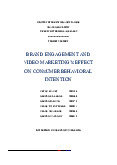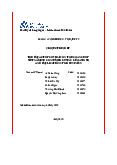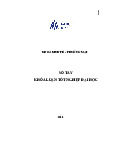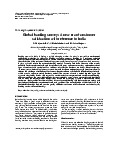







Preview text:
Đáp án - Review - Final Exam - M&A - 23.2A
Part 1: Multiple Choices 1. b 2. c 3. d 4. c 5. a 6. d 7. a 8. a 9. b 10. b 11. d 12. a 13. b 14. c 3 3 => 4 𝑋 4 𝑋 = 1𝑌 𝑌 = 0.75*45 30 = 1. 125 15. c Ans:
In this case D / V = 89,452 / (89,452 + 164,114.5) = 35.3%. 16. c. Giải thích:
Nếu giá trị nội tại của công ty mục tiêu là tương tự giá thị trường, mua cổ phiếu của công ty mục
tiêu trên thị trường là thương vụ có NPV = 0.
Đối với việc thâu tóm, phần chênh lệch nên xấp xỉ 30% giá thị trường công ty mục tiêu, tức $7.5.
Và giá trị tăng thêm trên mỗi cổ phiếu công ty mục tiêu nên cao hơn $7.5.
Liệu thương vụ có hiệu quả hay không phụ thuộc vào giá trị tăng thêm, vì vậy nói rằng công ty
không nên theo đuổi thương vụ là sai, khi chỉ căn cứ vào việc định giá công ty mục tiêu. 17. c Giải thích:
Sử dụng giá $45 cho công ty thâu tóm, giá mời chào của công ty thâu tóm với công ty mục tiêu là
$45*0.4235 = $19.06. Vì vậy, ta có thể xác định giá mời chào mà không cần biết số cổ phiếu của
công ty mục tiêu. Sau khi thông báo thương vụ, giá của công ty mục tiêu sẽ dịch chuyển đến
$19/cổ. Và sử dụng phần chênh lệch là 30%, giá trước deal của công ty mục tiêu có thể ước
lượng là $19/1.3 = $14.7, nhỏ hơn $17. Cuối cùng, giá mời chào phụ thuộc vào giá của công ty thâu tóm. 18. c Giải thích
Using a price of $35 for the acquirer, the value of the offer is $35*0.4235 = $14.83. Thus, the
offer if too low in the eyes of the target, which demands an offer of at least $14.5*1.3 = $18.9.
The acquirer can increase the offer by increasing the exchange ratio, or by paying cash. But since
the acquirer does not agree that its stock is overvalued, issuing a lot more stock is likely to be
worse than paying in cash (if feasible for the acquirer).
Sử dụng giá $35 cho công ty thâu tóm, giá chào mua là $35*0.4235=$14.83
Vì vậy, giá chào là thấp theo quan điểm của công ty mục tiêu, và nó đòi hỏi giá chào phải tối
thiểu là $14.5 *1.3 = $18.9.
Công ty thâu tóm có thể tăng giá chào bằng cách tăng tỷ lệ trao đổi hoặc trả bằng tiền mặt.
Nhưng vì công ty thâu tóm không đồng ý giá cổ phiếu của nó bị định giá cao, phát hành thêm cổ
phiếu có thể sẽ tệ hơn là trả bằng tiền mặt (nếu công ty thâu tóm có thể). 19. c Answer:
To figure out whether an investment creates value you need not only the rate of return but also an
appropriate discount rate. We are not given the discount rate, so we cannot establish whether
these investments are positive NPV or not. The required rate of return of investment does not
have to be equal to 12% (that is the case only if the investment is zero NPV). In Finance returns
measure risk, so it is very likely that investment 1 is riskier than investment 2. That is also the
reason why investment 1 does not necessarily create more value than investment 2.
Để xem xét liệu khoản đầu tư tạo ra giá trị hay không, bạn cần không chỉ là tỷ suất lợi nhuận mà
còn một suất chiết khấu phù hợp. Ta không được cung cấp suất chiết khấu, vì vậy ta không thể
kết luận 2 đầu tư này có NPV dương hay không. Tỷ suất lợi nhuận yêu cầu của khoản đầu tư 1
không nhất thiết bằng 12% (chỉ trong trường hợp khoản đầu tư này có NPV = 0). Trong tài
chính, lợi nhuận đo lường rủi ro, vì vậy đầu tư 1 có thể rủi ro hơn đầu tư 2. Đó cũng là lý do vì
sao đầu tư 1 không cần thiết tạo nhiều giá trị hơn đầu tư 2. 20. d. Answer:
Tỷ suất lợi nhuận của chứng khoán thanh khoản như là trái phiếu nước Mỹ là thước đo của tỷ
suất lợi nhuận yêu cầu đối với chứng khoán đó. Vì vậy, tỷ suất lợi nhuận yêu cầu giảm theo thời
gian, nghĩa là trái phiếu nước Mỹ không hẳn là trở thành khoản đầu tư không hiệu quả. Nếu thị
trường là hiệu quả, NPV của khoản đầu tư vào những trái phiếu này sẽ bằng 0 ở năm 2018 và năm 2021. 20. d Giải thích:
In this case D / V = 89,452 / (89,452 + 164,114.5) = 35.3%.
The WACC for Charter is 4%*(1 - 21%) *35.3% + 6.95%*(1 – 35.3%) = 5.61% 21. a
The exchange ratio is the deal price divided by the acquirer price, so 13 / 15 = 0.867. The
number of shares issued is then 0.867*20 million = 17.333 million. 22. c
Here is the goodwill calculation (notice the total acquisition cost is $13*20 million = 260 million dollars): Goodwill calculation:
Total acquisition cost (Tổng chi phí thâu tóm) 260
Book equity of target (Giá trị sổ sách của vốn cổ 200 phần công ty mục tiêu)
Premium over book (chênh lệch so với giá trị sổ 60 sách)
Step up in Net PPE (sự tăng lên trong Tài sản dài 20 (assumption) hạn ròng)
Goodwill (Lợi thế thương mại) 40 = 60-20 23. d
Here is the solution with the merged balance sheet (key items in bold): Acquirer Target Merged firm Current assets 200 Current assets 120 Current assets 320 Property, plant and 600 Property, plant and 230 Property, plant and 850 equipment equipment equipment Land 150 Land 50 Land 200 Net plant and 450 Net plant and 180 Net plant and 650 equipment equipment equipment Goodwill 50 Goodwill 0 Goodwill 90 Total assets 850 Total assets 350 Total assets 1260 Current liabilities 100 Current liabilities 20 Current liabilities 120 Long-term debt 250 Long-term debt 120 Long-term debt 370 Other liabilities 50 Other liabilities 10 Other liabilities 60 Total liabilities 400 Total liabilities 150 Total liabilities 550 Total equity Total equity Total equity 710
The key changes are in net plant and equipment and goodwill. 24. b
Here is the solution with the merged income statements. Acquirer Target Merged firm Sales 900 Sales 650 Sales 1550 Costs 720 Costs 550 Costs 1270 EBITDA 180 EBITDA 100 EBITDA 280 Depreciation and 65 Depreciation and 25 Depreciation and 92 amortization amortization amortization EBIT 115 EBIT 75 EBIT 188 Interest payments 10 Interest payments 6 Interest payments 16 Taxable income 105 Taxable income 69 Taxable income 172 Taxes at 21% 22.05 Taxes at 21% 14.49 Taxes at 21% 36.1 Net income 82.95 Net income 54.51 Net income 135.9
Depreciation reflects the step up in asset value. 25. a.
Here are the calculations with the EPS values: Acquirer Target Merged firm (stock) Sales 900 Sales 650 Sales 1550 Costs 720 Costs 550 Costs 1270 EBITDA 180 EBITDA 100 EBITDA 280 Depreciation and 65 Depreciation and 25 Depreciation and 92 amortization amortization amortization EBIT 115 EBIT 75 EBIT 188 Interest payments 10 Interest payments 6 Interest payments 16 Taxable income 105 Taxable income 69 Taxable income 172 Taxes at 21% 22.05 Taxes at 21% 14.49 Taxes at 21% 36.1 Net income 82.95 Net income 54.51 Net income 135.9 Shares outstanding 50 Shares outstanding 20 Shares outstanding 67.3333 3 EPS 1.659 EPS 2.726 EPS 2.018
Remember that this increase in EPS is purely mechanical and does not reflect synergies.
Part 2: Practice Questions Question 1:
a. Calculate Free cash flow to equity in 2022 and 2023
Hint: FCFE = EBIT - Taxes + Depreciation - Capex - change in WC - (Debt repayment +interest expense) Answer:
FCFE 2022 = EBIT - Taxes + Depreciation - Capex - change in WC - (Debt repayment
+interest expense) = 265 - 98.4 + 15 - 30 - 40 - (35+19) = 57.6 mil
FCFE 2023 = 371 - 140.8 +19 -20 -100 - (35 +19) = 75.2 mil
b. Calculate Free cash flow to the firm in 2022 and 2023
Hint: FCFF = EBIT + Depreciation - Capex - change in WC - tax rate * EBIT Answer:
FCFF 2022 = EBIT + Depreciation - Capex - change in WC - tax rate * EBIT
= 265 + 15 - 30 - 40 - 40%*265 = 104 mil
FCFF 2023 = 371 + 19 - 20 - 100 - 40%*371 = 121.6 mil Question 2: Answer:
a. What is the cost of equity?
CAPM: Re = Rf +beta* (Rm - Rf) = 6.25% + 1.1*(5.5%) = 12.3%
b. What is the after-tax cost of debt? Answer:
after tax cost of debt = (1 - tax rate) * cost of debt = 6.45%*(1-40%) = 3.9%
c. What is the weighted average cost of capital? Answer:
WACC = after tax cost of debt * 𝑑𝑒𝑏𝑡 + cost of equity * 𝑒𝑞𝑢𝑖𝑡𝑦
𝑡𝑜𝑡𝑎𝑙 𝑐𝑎𝑝𝑖𝑡𝑎𝑙
𝑡𝑜𝑡𝑎𝑙 𝑐𝑎𝑝𝑖𝑡𝑎𝑙 = 3.9%* 2
+ 12.3%* 32*1.13 = 3.9%*5.24% + 12.3%*94.76% = 11.9% 2 +32*1.13 2+32*1.13 Question 3: Đáp án: 0 1 2 3 4 2020A 2021E 2022E 2023E 2024E 2025E FCF 8,123.81 9,897.24 10,906.79 11,890.80 12,384.11 12,897.89 WACC 10.6% Terminal Long term growth 3.00% value 174,800.35 Discount factor 0.90 0.82 0.74 0.67 Discounted FCF 9,861.47 9,720.77 9,153.76 125,441.05 Enterprise value 154,177.06 Question 4:
a. Estimate free cash flow to the firm in 2021. Tính dòng tiền tự do của công ty trong năm 2021. Answer:
FCF 2011 = EBIT + Depreciation - Capex - change in WC - tax rate * EBIT
= 330 + 10 - 20 - 10 - 40%*330 = 178 mil
b. Estimate the firm’s weighted average cost of capital. Tính chi phí vốn trung bình của công ty. Answer:
𝑐𝑜𝑠𝑡 𝑜𝑓 𝑒𝑞𝑢𝑖𝑡𝑦 = 𝑟 + β * 𝑟𝑖𝑠𝑘 𝑝𝑟𝑒𝑚𝑖𝑢𝑚 = 5% + 1. 0 * 5. 5% = 10. 5% 𝑓
𝑊𝐴𝐶𝐶 = (1 − 𝑡𝑎𝑥 𝑟𝑎𝑡𝑒) * 𝑐𝑜𝑠𝑡 𝑜𝑓 𝑑𝑒𝑏𝑡 * 𝐷𝑒𝑏𝑡
𝐷𝑒𝑏𝑡 + 𝐸𝑞𝑢𝑖𝑡𝑦 + 𝑐𝑜𝑠𝑡 𝑜𝑓 𝑒𝑞𝑢𝑖𝑡𝑦 * 𝐸𝑞𝑢𝑖𝑡𝑦
𝐷𝑒𝑏𝑡 + 𝐸𝑞𝑢𝑖𝑡𝑦
= (1 − 40%) * 7% * 30% + 10. 5% * (1 − 30%) = 8. 61%
c. Estimate the enterprise value of the firm at the end of 2021, assuming that it will
generate the value of free cash flow estimated in sentence a. Indefinitely. Tính giá
trị doanh nghiệp của công ty vào cuối năm 2021, giả định rằng nó sẽ tạo ra dòng
tiền như đã tính ở câu a.
𝐸𝑛𝑡𝑒𝑟𝑝𝑟𝑖𝑠𝑒 𝑉𝑎𝑙𝑢𝑒 = 𝐹𝐶𝐹 𝑊𝐴𝐶𝐶 = 178
8.61% = 2, 067. 36 𝑚𝑖𝑙
d. Estimate the value of the equity of the firm at the end of 2021. Tính giá trị vốn cổ
phần của công ty vào cuối năm 2021.
𝑣𝑎𝑙𝑢𝑒 𝑜𝑓 𝑡ℎ𝑒 𝑒𝑞𝑢𝑖𝑡𝑦 𝑜𝑓 𝑡ℎ𝑒 𝑓𝑖𝑟𝑚 = 𝐸𝑛𝑡𝑒𝑟𝑝𝑟𝑖𝑠𝑒 𝑉𝑎𝑙𝑢𝑒 − 𝑑𝑒𝑏𝑡 = $867. 36 𝑚𝑖𝑙
e. Estimate the value per share at the end of 2021. Tính giá trị của mỗi cổ phiếu vào cuối năm 2021.
𝑣𝑎𝑙𝑢𝑒 𝑝𝑒𝑟 𝑠ℎ𝑎𝑟𝑒 = 𝑣𝑎𝑙𝑢𝑒 𝑜𝑓 𝑡ℎ𝑒 𝑒𝑞𝑢𝑖𝑡𝑦 𝑜𝑓 𝑡ℎ𝑒 𝑓𝑖𝑟𝑚
𝑁𝑜. 𝑜𝑓 𝑐𝑜𝑚𝑚𝑜𝑛 𝑠ℎ𝑎𝑟𝑒𝑠 𝑜𝑢𝑡𝑠𝑡𝑎𝑛𝑑𝑖𝑛𝑔 = $867.36𝑚𝑖𝑙 2.5𝑚𝑖𝑙 = $346. 95
Part 3: Theory Questions
1. Summarize the phases of the M&A process.
2. Describe techniques used to “close to gap” when buyers-sellers cannot agree on a price
3. What is leveraged buyout (LBOs)? And how do LBOs create value?
4. What is a merger or an acquisition? Distinguish them and give an example of merger.
5. List the strategies of alternative restructuring. Distinguish them.




